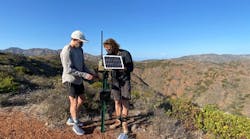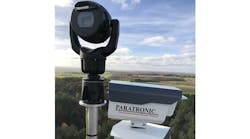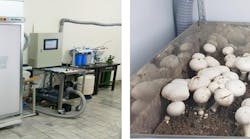Plastic particles, such as from beverage bottles, undergo a multiple-step recycling and inspection process before they are reused in new plastic products.
Automation plays a key role in each step of the process, and Eagle Vizion (Sherbrooke, Quebec, Canada) makes equipment to meet these needs. One such product is the Flake Analyzer, an automated inspection system that uses AI-enabled machine vision to analyze shredded plastic, checking for evidence of metal or other foreign particles. The unit identifies more than 30 categories of materials, including various plastic polymers, metal and paper.
Providing high quality raw materials is particularly important for reuse in food-grade applications, where plastic materials must contain no more than 10 parts per million (ppm) of contaminants, explains Nathanaël Lortie, president of Eagle Vizion.
“They cannot put whatever plastics they want to back to water bottles, they want it to be a pure product,” Lortie says. Referring to the Flake Analyzer, he adds, “We're that last stretch before it goes back to food grade applications.”
Demand for food-grade plastic polymers is expected to outpace supply, putting pressure on recyclers to meet consumers’ growing appetite for environmentally friendly products. In a recent report, McKinsey & Company (New York, NY, USA) predicts that demand for these polymers will rise 15% per annum between 2020-2030, while supply will grow 1% over the same period.1
The demand-supply mismatch puts pressure on the recycling industry to improve its multi-step process. Once plastic bottles arrive at recycling facilities, they are sorted, shredded and then the particles are washed and sorted again.
The final step is the Flake Analyzer, which verifies purity by examining the shredded plastic, which has been sorted by type. The Flake Analyzer has been on the market since 2015 and updated with AI-enabled functionality in 2022. It checks the composition of many types of plastics—from PVC to rPET, which is the recycled polymer used in plastic beverage bottles and food containers.
Eagle Vizion, one of a few companies marketing solutions for recycling plastics, has sold the Flake Analyzer to customers in North America and Europe, according to Lortie.
Machine Vision and AI Inspect Plastic Particles
The Flake Analyzer automates a manual process in which lab technicians measure plastic flakes. They identify “contaminants within the flakes by visual inspection and a cooking process,” Lortie says.
The Flake Analyzer not only automates the process but also determines “more types of combinations of polymers” than was possible with manual inspection.
If the system is integrated into an automated line, the Flake Analyzer will direct the flakes to the appropriate next step in the process, such as storage, shipping to a customer, a trash silo or recirculation through the recycling process. The Flake Analyzer uses machine vision and AI to identify particles down to 0.25 mm in size, providing information on material composition, size and color as well as other characteristics.
“So, these are all attributes that we measure simultaneously and in a live manner, so that you can get real information as we're testing material,” Lortie says. “Every single flake is analyzed one by one.”
Using images from a short-wave infrared (SWIR) camera, which Lortie declined to name, software determines the chemical composition of material, indicating a specific type of plastic, metal or other substance.
“With SWIR, we detect ‘signatures,’ or specific absorption structures that are specific for certain chemical structures. More specifically, we detect O-H and C-H structures,” Lortie says.
A color 5 MPixel RGB camera provides information on the color of the particle, or flake, such as white or green. Both cameras operate at a frame rate of close to 3000 hertz, or 3,000 images per second.
The RGB camera is a GigE Genie Nano from Teledyne DALSA (Waterloo, Ontario, Canada). Lenses for the Teledyne cameras typically are from Moritex (San Jose, CA, USA) or Kowa American Corp. (Torrance, CA, USA).
With the addition of AI-enabled algorithms in 2022, Eagle Vizion added information on whether the color is translucent or opaque as well as whether it is rigid or flexible.
Eagle Vizion built the new capabilities over time, using Astocyte Software from Teledyne, which provides hardware-agnostic AI-enabled image processing. The software’s AI models support classification, anomaly detection, object detection and segmentation.
Training Deep Learning Algorithms
As is often the case in developing neural networks, engineers at Eagle Vizion worked diligently to amass image libraries. The company has about 100,000 labeled images and is adding new ones to the collection continually.
Lortie says the transition to AI-enabled functionality occurred gradually as the company diverted more of the Flake Analyzer’s decision making to algorithms. “It took us over a year to validate everything and test it at different sites,” Lortie says.
And Eagle Vizion isn’t done—it can add new functionality as needed to meet the needs of the market.
References
- Diakhaby M, Feber D, Mirza Y, Nordigården D, Shields B, Wallach J. Filling the gap: Boosting supply of recycled materials for packaging. McKinsey & Company. September 2023. https://www.mckinsey.com/industries/packaging-and-paper/our-insights/filling-the-gap-boosting-supply-of-recycled-materials-for-packaging







